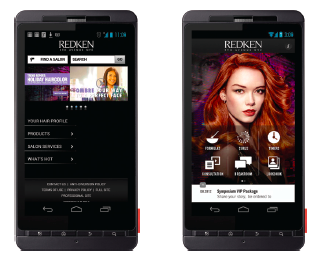For L’Oreal, mobile is a cornerstone of a smart marketing strategy that
encompasses many channels. Especially for the company’s Redken brand,
a 360-degree mobile effort focuses on custom mobile experiences for a
variety use cases: cosmetology students learning in a classroom, professional
hairdressers working in a salon, and consumers on the go looking for products
or services. For each one, the company takes a different approach, and all have
become highly successful.
L’Oreal considered mobile highly strategic from the start. When Sarah Liang,
Director of Integrated Marketing Communications for L’Oreal USA, joined the
company in 2005, the marketing team was already investigating ways to reach
its mobile audiences. Today, Redken takes a three-pronged approach, offering
educational tools for cosmetology students through a tablet app, in-salon tools
for stylists to upgrade the salon experience through a smartphone app, and
access to product information and salon locations to consumers through a
mobile-optimized website.
Getting to the root of the on-the-go user
The company conducted significant research to hone its mobile marketing
strategies and adapt it to each target audience. For example the company
discovered that stylists—who stand behind a chair versus sitting behind a desk
with a computer—upgrade to the latest smartphones quickly. In 2012, 66% of
stylists reported owning a smartphone—a statistic that was surprising, because
usage among the general population was about 50%.
The marketing team also conducted a purchase intent study focused on desktop
searchers. After visiting the desktop site, 80% of users took action: 23% called a
salon to check availability, or ask about services and costs; 23% visited the salon
and bought a product. Because smartphone users usually show higher intent to
action, Redken believes it can meet or exceed these results on the mobile web.
Mobile marketing with style
With statistics such as these in mind, Redken has created several mobile
options targeted to its audiences. For consumers, the company created a
mobile-friendly site. It includes a salon locator, product catalog, product
recommendations, and a “look book.” An important key performance indicator
(KPI) for the mobile website—one that is closely monitored—is the number of
salon searches. “We saw how important our mobile site was for reaching new
consumers who are on the go. We are meeting our objective of bringing them
into a salon,” says Liang.
In 2010, when L’Oreal did not have a mobile-optimized site for Redken, only
3% of searches on the salon locator came from smartphone devices. In
2011, Redken launched its mobile website, m.redken.com, and saw mobile
traffic increase to 10% of total salon searches. In 2012, with help of their
agency Labelium, they deployed Google Mobile Ads. “After we launched our
mobile site for Redken and Google mobile ads, the percentage of total salon
searches coming from smartphone devices leapt to 23%—that’s a 519%
increase year-over-year,” says Liang.
A formula for success
For professional stylists, the primary objective is engagement. For them,
Redken created smartphone that educates about applying the right
colors and formulas. Stylists can use the to identify a specific client need based on a variety of variables (color, type of hair, and so on) and
provide a suggested solution, customized for every client. The app has
increased stylists’ comfort level with Redken’s hair coloring products, as well as
deepened the relationship with the brand.
“For a stylist, switching color lines is very daunting,” Liang explains. “It would
be like going from a Mac to a PC and not knowing exactly where to click or
how things work. But now, we’ve seen the average time spent per person on
the app is an impressive 27 minutes per session with more than 8 sessions
per months—that’s how we know we’re achieving good education and
engagement.”
Education goes mobile
Now Redken is transforming the education experience for its student audiences
through tablet devices. At the beginning of every class conducted at the
Redken Exchange Academy, a school for advanced, licensed cosmetologists,
instructors ask students to download the app before the class begins to provide
a guided, immersive educational experience. The app acts as a virtual notebook
so students can save their notes for future reference and build upon their
educational journey. The app is used as an education, sales, and marketing
tool all in one that saves time and money previously spent creating various
textbooks and classroom materials.
Untangling data to make smart decisions
The complex chain of distribution for the products makes it challenging to
create a sophisticated attribution model for mobile. However, the company is
very smart about measurement. Marketers conduct focus groups, go along with
salespeople on sales calls, and more, in their efforts to gather intelligence about
what works in mobile.
For Redken, the ultimate KPI on the mobile site is the salon locator, which they
know is tied to purchase intent and sales. “Especially because we’ve had such
strong search traffic growth for the salon locator through a mobile optimized
site and Google Mobile Ads, everyone here understands how successful mobile
marketing can be,” says Liang. “Ultimately what we’ve learned is that you have to
know your audience, and develop a robust strategy across screens that fits their
need the most.”
